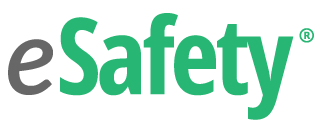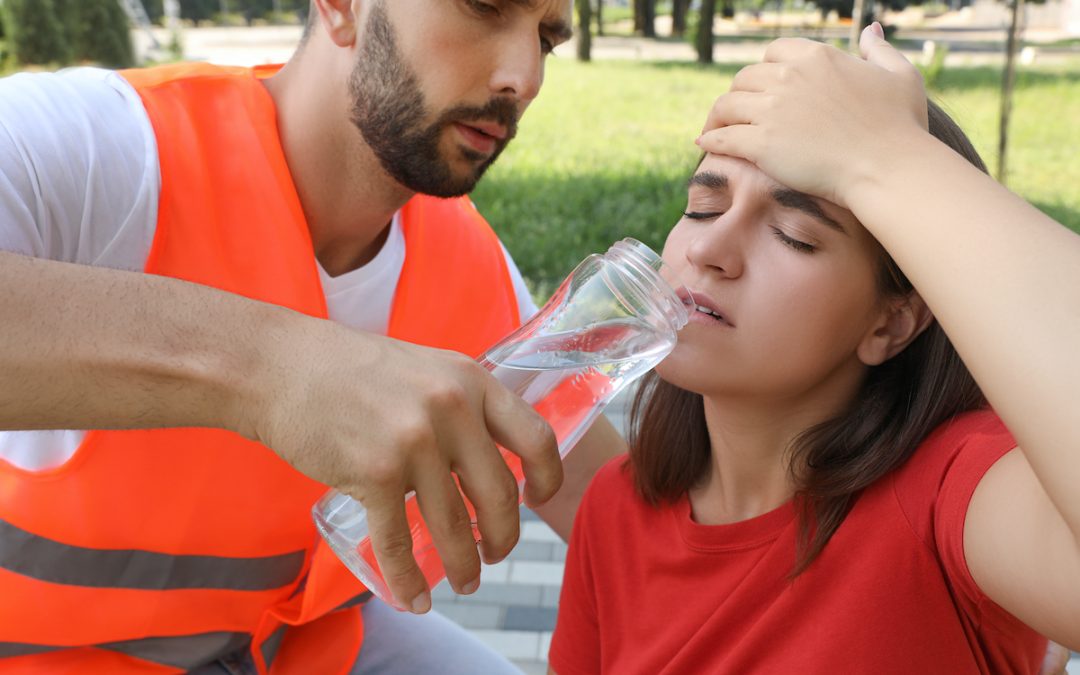Heat-related illnesses affect thousands of workers annually, with OSHA reporting that dozens of preventable deaths occur each year due to workplace heat exposure. OSHA also acknowledges that the actual numbers of these incidents are likely even higher due to underdiagnosis, underreporting, and jurisdiction variance in definitions of heat-related illnesses.
Dangerous heat exposure doesn’t just affect those working outdoors – indoor workers in hot environments face similar risks year-round. This is why understanding how to identify, treat, and prevent heat-related illnesses is essential for maintaining a safe workplace.
eSafety’s Heat-Related Illness series was developed to create a better understanding of the different types of heat-related illnesses, their signs and symptoms, and workplace prevention methods. This updated guide provides information you can use to recognize and respond to heat-related emergencies before they become life-threatening.
Understanding Heat-Related Illnesses
Heat-related illnesses occur when our natural cooling mechanisms become overwhelmed by environmental heat, physical exertion, or a combination of factors – some of which are found in many workplaces.
Environmental conditions like high temperature and humidity reduce the body’s cooling ability, while direct sun exposure and limited air movement compound the problem.
The nature of work activities matters as well. Physical exertion generates internal heat, and protective clothing may restrict cooling. Individual factors can further create substantial variation in heat tolerance, with acclimatization status, physical fitness, age, and certain medical conditions all playing potential roles.
For accurate heat risk assessment, Wet Bulb Globe Temperature (WBGT) provides the most comprehensive measurement by accounting for temperature, humidity, air movement, and radiant heat. Both NIOSH and OSHA recommend using WBGT to determine appropriate work-rest schedules and other preventive measures.
Heat-Related Illness Prevention
Preventing heat-related illnesses in your organization takes a combination of environmental modifications, administrative practices, and personal protective measures. For a more in-depth look at what this entails, check out our Heat-Related Illness Prevention in the Workplace post.
Recognizing and Treating Heat-Related Illnesses
Unfortunately, even the best preventive measures don’t completely eliminate all risk of heat-related illnesses that can occur in the workplace. That means the ability to quickly recognize and appropriately respond to these conditions becomes invaluable in preventing progression to more serious or even life-threatening situations.
Heat-related illnesses represent a spectrum of conditions, increasing in severity from relatively minor heat rashes to potentially fatal heat strokes. Understanding the distinct characteristics of each condition enables you and your team to identify problems early and implement the appropriate intervention.
#1 Heat Rash
Heat rash, also called prickly heat or miliaria, occurs when sweat ducts become blocked, trapping perspiration under the skin. Though rarely dangerous, it causes discomfort that may impact work performance.
Heat rashes develop most commonly where skin touches skin, such as in joint areas, or clothing creates friction. Risk factors include hot, humid environments, tight-fitting clothing, and creams that block sweat ducts.
Symptoms
- Clusters of small, red bumps resembling pimples or blisters
- Appears primarily on the neck, upper chest, in elbow creases, behind the knees, and groin areas
Treatment
- Move to a cooler, less humid environment
- Keep affected areas dry
- Take a cool shower and allow skin to air dry
- Apply cool compresses to irritated areas
While heat rash typically resolves within days, seek medical attention if the rash doesn’t improve, shows signs of infection, spreads extensively, or is accompanied by fever.
#2 Heat Syncope
Unlike other heat illnesses, heat syncope doesn’t necessarily concern an increase in core temperature. Rather, it results from blood vessel dilation and reduced blood flow to the brain. Possible risk factors are prolonged standing in hot environments, lack of acclimatization, sudden position changes, dehydration, and certain medications.
Symptoms
- Sudden dizziness
- Light-headedness during prolonged standing
- Light-headedness after rising suddenly
- Fainting for a short duration
Treatment
- Have the person sit or lie down in a cool place
- Provide cool water or an electrolyte drink for them to drink slowly
#3 Heat Cramps
Heat cramps are painful muscle spasms during or after intense physical exertion in hot environments. These painful contractions result from the combination of fluid and electrolyte losses through heavy sweating, particularly when water is replaced without enough salt replenishment.
Risk factors include intense physical activity in heat, lack of acclimatization, previous history of heat cramps, poor conditioning, high sweat rates, and inadequate electrolyte replacement.
Symptoms
- Painful muscle spasms or cramping in the legs, arms, or abdomen
- Excessive sweating
Treatment
- Stop all activity immediately
- Loosen clothing
- Move to a cool, shaded area
- Drink 8 ounces of clear juice or an electrolyte beverage every 15 to 20 minutes
- Apply cool, wet compress to the cramping area
Seek medical care if cramps don’t improve within an hour, the person is on a low-sodium diet, has heart problems, or develops symptoms of more serious heat-related illnesses.
#4 Heat Exhaustion
Heat exhaustion develops when your body’s cooling mechanisms become overwhelmed by heat exposure and dehydration. This condition indicates that your body is nearing its limits for heat tolerance, with core temperature beginning to rise as compensatory mechanisms start to fail.
Heat exhaustion risk factors include prolonged heat exposure, high humidity, strenuous activity, inadequate fluid intake, lack of acclimatization, certain medications, age extremes, and underlying medical conditions.
It’s important to know that without prompt intervention, heat exhaustion can rapidly progress to life-threatening heat stroke. That makes it essential to recognize the symptoms, many of which resemble the flu, and know what to do when they are present.
Symptoms
- Heavy sweating
- Fast heart rate
- Nausea or vomiting
- Fatigue
- Headache
- Dizziness
- Irritability
- Slightly elevated body temperature
- Thirst
- Dehydration
Treatment
- Move the person to a cool, less humid area immediately
- Drink 8 ounces of water or a drink with electrolytes every 15 to 20 minutes
- Loosen clothing and remove any unnecessary clothing, like shoes and socks
- Have the person lie down and apply cool wet compresses or ice packs under the arms, on the neck, ankles, groin, and behind the knees
- Fan air across the body
#5 Rhabdomyolysis
Rhabdomyolysis (“rhabdo”) occurs when damaged muscle tissue breaks down rapidly, releasing its contents (myoglobin, enzymes, electrolytes) into the bloodstream. Of particular concern is the protein myoglobin, which can cause severe kidney damage.
While traditionally associated with traumatic injuries, rhabdomyolysis increasingly appears in occupational settings where workers perform intense physical labor in hot environments. Risk factors for rhabdomyolysis include extreme physical exertion in heat, sudden increases in work intensity, dehydration, previous heat illness, certain medications, and genetic predispositions.
Symptoms
- Muscle cramps or pain (myalgia)
- Abnormally dark-colored urine or decreased urine output
- Weakness
- Inability or reduced ability to perform physical activities at a typical level or duration
- Joint pain or stiffness
Treatment
- Immediately call for emergency medical services
- Stop activity
- Drink water while awaiting medical help (if conscious)
Rhabdomyolysis always requires immediate medical attention, with kidney damage potentially beginning within hours. Anyone presenting symptoms – especially dark urine after intense physical exertion – should seek emergency care ASAP.
#6 Heat Stroke
Heat stroke is the most severe form of heat-related illness and constitutes a true medical emergency. This life-threatening condition occurs when the body’s temperature-regulating mechanisms completely fail, allowing core temperature to rise above 104°F (40°C). Without rapid cooling and emergency medical treatment, heat stroke frequently results in permanent disability or death.
Risk factors include any combination of physical exertion and high temperatures, lack of acclimatization, poor physical fitness, obesity, dehydration, certain medications, and previous heat stroke.
Medical professionals recognize two distinct types:
Classic heat stroke typically develops over several days of heat exposure without adequate relief, usually affects vulnerable populations, and often involves cessation of sweating.
Exertional heat stroke develops rapidly during intense physical activity in hot conditions, typically affects younger, active individuals, and often features continued sweating.
Either way, this is the most serious type of heat-related illness.
Symptoms
- Very high body temperature (above 103°F, often 104°F-106°F)
- Slurred speech
- Confusion
- Unconsciousness
- Convulsions or seizures
- Rapid heart rate
- Lack of sweating (classic heat stroke)
- Heavy sweating (exertional heat stroke)
Every workplace where heat exposure occurs should have an emergency response protocol prepared to handle a case of heat stroke.
Emergency Response Protocol
- Call 911 immediately
- Move the victim to a cool, shaded area
- Remove or loosen unnecessary clothing
- Provide cool drinking water
- Give cold-water bath or ice bath
- Fan air over their body
- Place wet cloths on skin
- If you are unable to place the person in a bath apply cold, wet compresses or ice packs under the arms, on the neck, ankles, groin, and behind the knees while waiting for external medical care
Heat stroke often causes long-term effects including permanent brain damage, organ failure, cardiovascular complications, and increased susceptibility to future heat illness.
Creating Your Effective Heat Safety Program
Protecting your workers from heat-related illnesses takes a comprehensive, systematic approach that addresses hazards before they cause harm. A well-designed program integrates preventive measures into daily operations and establishes a culture where heat safety becomes second nature.
Risk Assessment
The foundation of an effective heat safety program begins with a thorough risk assessment – systematically identifying heat hazards in your workplace by evaluating environmental conditions, work activities, and PPE requirements that might increase heat stress.
Consider workforce demographic factors, acclimatization status, and previous incidents to identify patterns or problem areas requiring special attention.
Program Elements
Your program should include several essential elements, beginning with a clear policy statement establishing management’s commitment to heat safety. From there, educational training and involvement for everyone including administrators, supervisors, and individual employees is a pivotal part in creating a successful program, as everyone plays a role in monitoring and supporting the health and wellness of the team.
Document preventive measures comprehensively, including:
- Work practice adjustments
- Engineering controls
- Monitoring procedures
Establish training requirements for both initial and refresher sessions, and develop clear emergency response procedures for heat-related incidents.
Implementation Strategies
Successful implementation takes a progressive approach, beginning in high-risk areas and expanding systematically. Clear communication reinforces requirements through multiple formats, while ongoing performance monitoring maintains effectiveness via regular audits, near-miss reporting, and worker feedback mechanisms.
Your Next Steps in Heat Illness Safety
While it may feel unsettling to learn about heat-related illnesses, it’s important to recognize the symptoms and their related conditions so you can respond appropriately and call for medical attention as soon as possible when necessary.
Understanding the types of heat-related illnesses is just the beginning. To fully protect your people:
- Assess your workplace for specific heat hazards and vulnerabilities
- Develop a comprehensive heat illness prevention program
- Train supervisors and workers to recognize and respond to heat illness
- Implement engineering and administrative controls appropriate for your worksite
- Prepare for emergencies with clear response protocols
eSafety’s Heat-Related Illness Awareness course provides extensive training on heat illness prevention, recognition, and response. Our course helps you meet your training obligations while giving your workers the knowledge they need to stay safe.
For more information about our heat illness prevention course or other safety training needs, contact our team online or request a free quote today!

